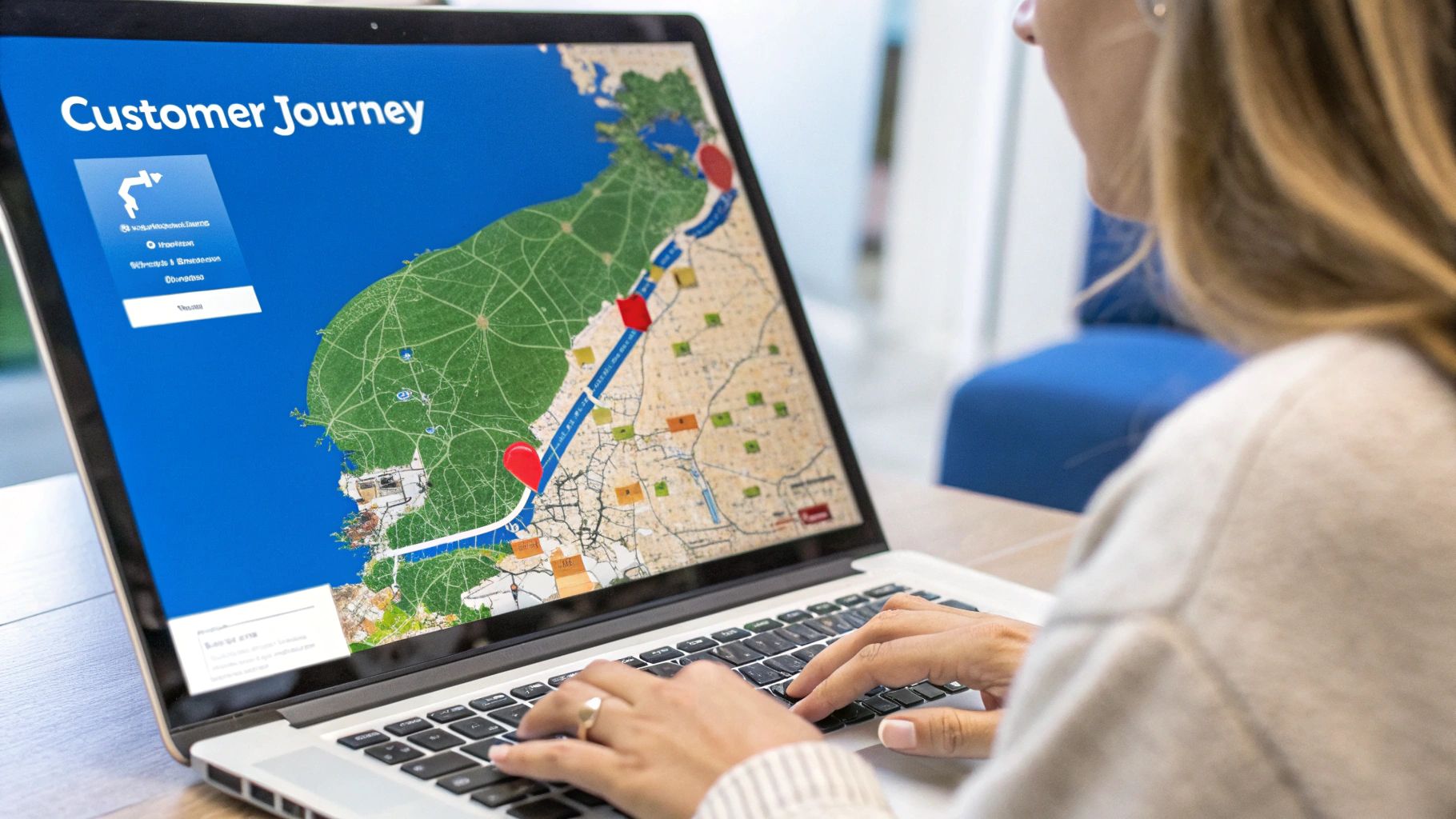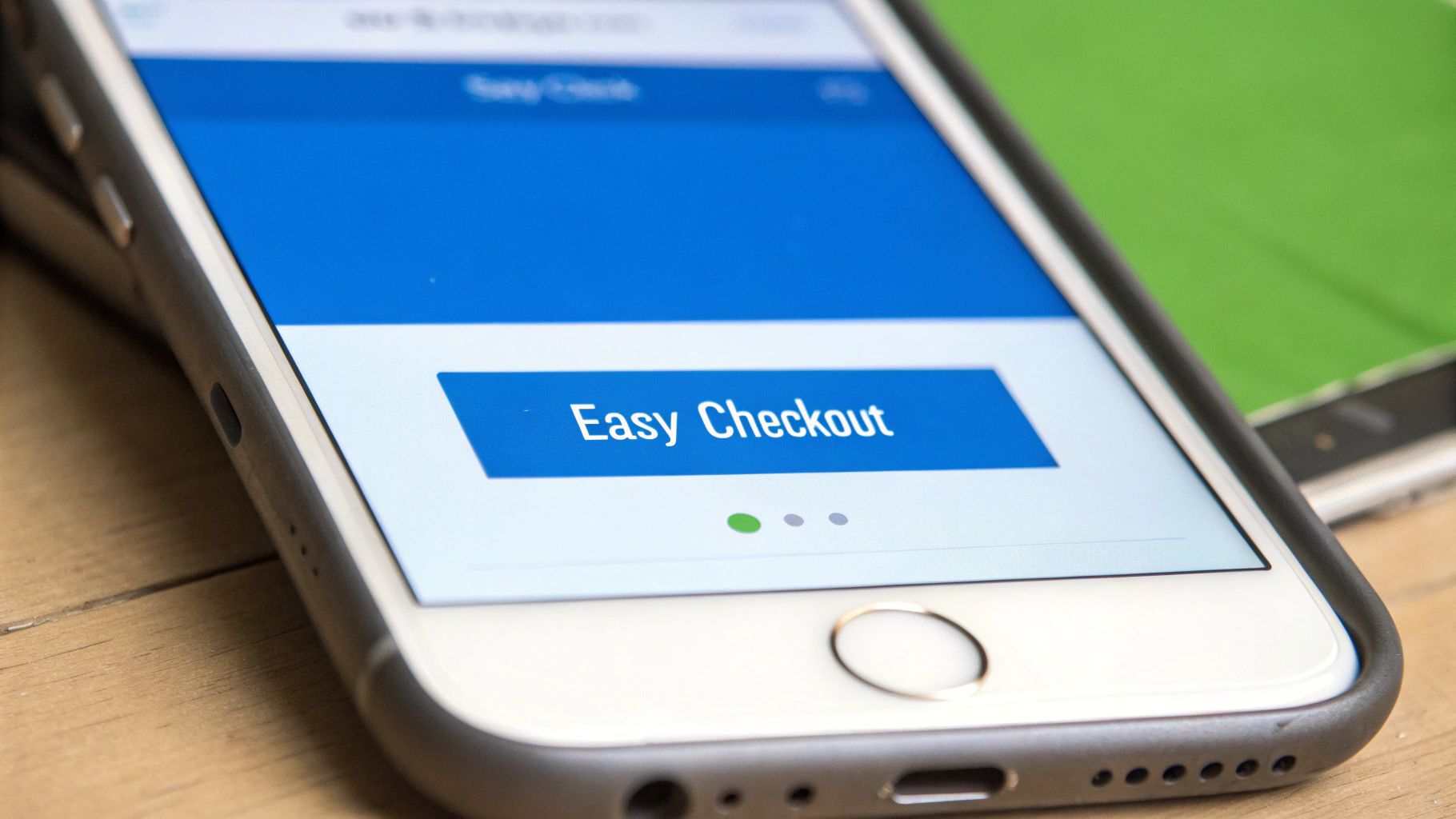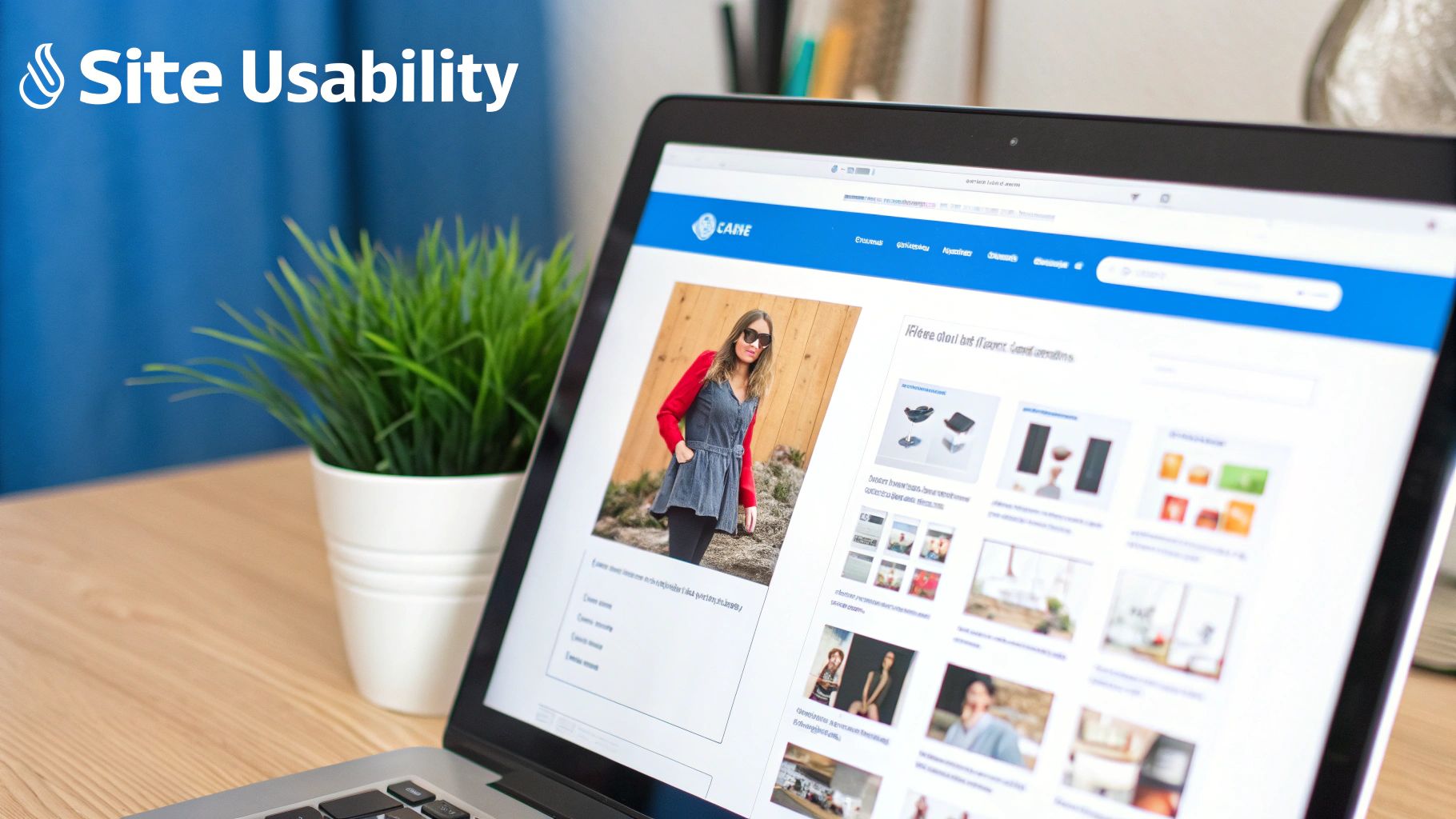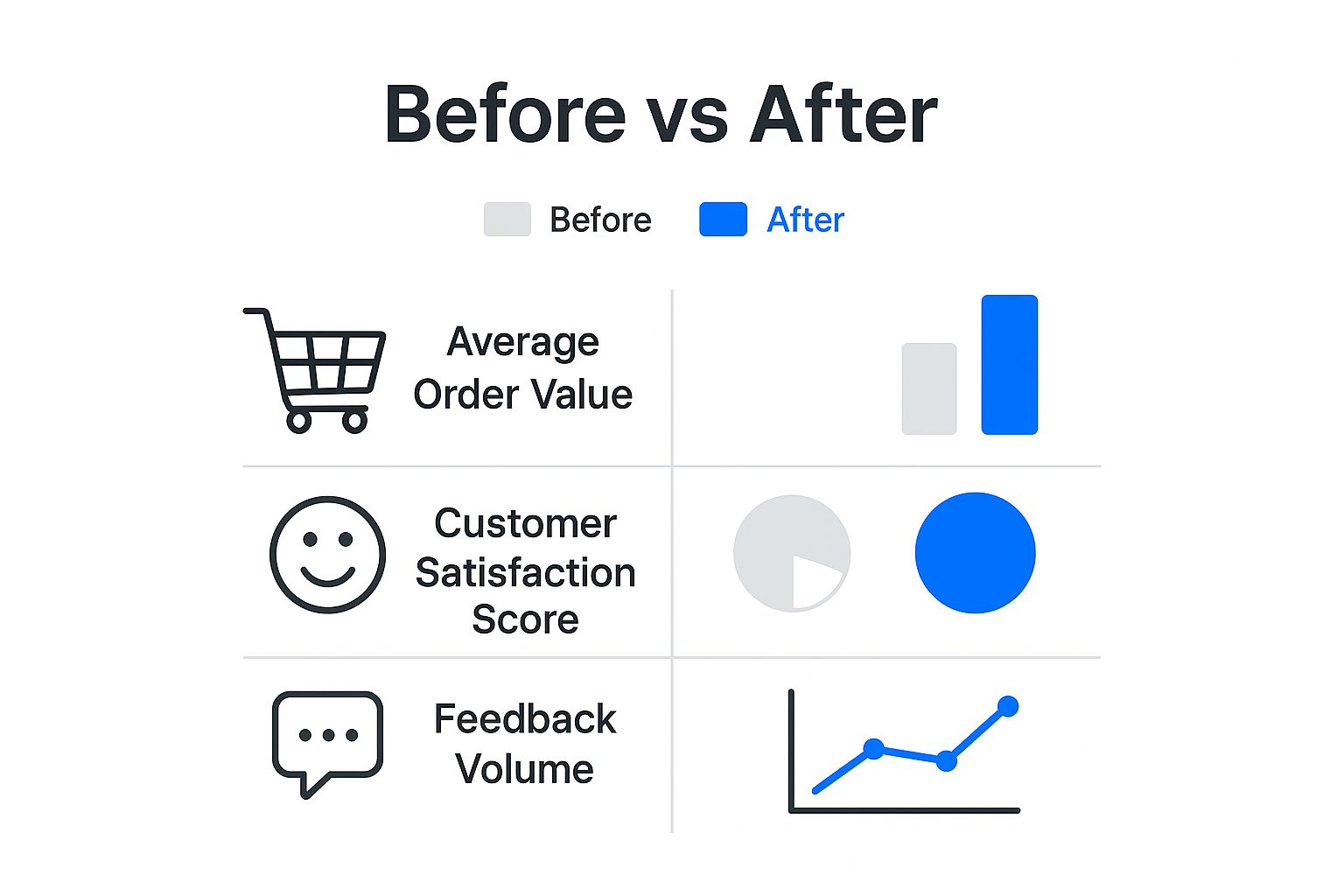Improving your ecommerce customer experience comes down to mastering three things: deep personalization, a frictionless digital journey, and proactive customer support. Get these right, and you'll create a shopping process that doesn't just make a sale—it creates a lifelong fan.

In a crowded online marketplace, your product alone isn't enough to stand out. Let’s be honest, someone else probably sells something similar. The experience you provide is your real competitive advantage. It's everything from the first ad a customer sees to the moment they unbox their order.
A superior customer experience isn't just a "nice-to-have" or about making people happy. It’s a strategic investment that directly impacts your bottom line. When customers feel seen, understood, and valued, they come back, spend more, and tell their friends about you.
The stakes for getting this right are incredibly high. Modern shoppers have zero patience for clunky, impersonal, or confusing online stores.
In fact, a staggering 89% of eCommerce consumers say they’ll walk away from a brand after a single poor customer service experience. That one negative interaction can erase all your hard work. You can find more data on the real cost of bad CX over at invespcro.com.
When you consider that acquiring a new customer costs six to seven times more than keeping an existing one, investing in a great experience isn't just a good idea—it's essential for survival.
To help you get started, we've broken down the key areas of focus into a simple framework. This table outlines the core pillars that every modern ecommerce brand should be concentrating on right now.
Focusing your efforts on these three pillars will deliver the most significant and immediate improvements to your customer journey. They form the foundation for every strategy we’ll cover in this guide.
So, how do you actually build an experience that fosters loyalty and grows your revenue? It all boils down to excelling in those three key areas.
By focusing on these pillars, you can transform your customer journey from a simple transaction into a memorable experience that builds the kind of loyalty that lasts.
Your website is your digital flagship store. Every single click, scroll, and tap matters.
Think of it this way: a clunky, slow, or confusing site is the digital version of a cluttered storefront with a broken door. It sends customers running. Crafting a seamless on-site and mobile journey is the absolute foundation of a great customer experience.
Put yourself in your customer's shoes. They land on your site, maybe from a social media ad, and that first impression forms in a matter of seconds. If a big, beautiful banner image takes forever to load, you've already introduced friction. The goal is to make browsing feel effortless, guiding them smoothly from discovery all the way to checkout.
Speed isn’t just a techy metric; it’s a core part of the customer experience. In today's market, patience is in short supply. Even a one-second delay can send bounce rates soaring and conversions plummeting, which makes site optimization a total non-negotiable.
Modern shoppers have sky-high expectations for performance. Research shows that nearly 37% of mobile users expect a website to load in three seconds, and a staggering 47% will bounce if it takes any longer. You can dig into more of these trends over at Lucidworks, but the takeaway is clear: a fast, mobile-responsive site is critical for keeping customers engaged.
Here are a few practical ways to get there:
Once your site is fast, you need to make it dead simple to get around. If customers can't find what they're looking for, they can't buy it. This is where a powerful, intelligent search function becomes your secret weapon.
Don't settle for a basic search bar that only matches exact keywords. Invest in a solution that understands synonyms, handles typos, and offers auto-complete suggestions. For example, if someone searches for "running shoes," your site should absolutely show results for "sneakers" or "trainers." This simple touch turns a potentially frustrating search into a successful discovery.
Your navigation menu should be a clear, logical map of your store. Use straightforward categories and ditch the industry jargon. A truly well-designed site guides users where they want to go before they even have to think about it.
This on-site experience really sets the stage for everything that follows. A smooth, fast, and intuitive website ensures customers add products to their cart feeling confident and satisfied. That initial positive interaction is critical, as it builds momentum that carries all the way through the next phase, which you can learn more about by exploring what ecommerce fulfillment involves. A great website experience creates a ripple effect that lasts until the final delivery.

True personalization goes way beyond just sticking a customer's first name in an email subject line. We're talking about creating shopping moments that feel like they were built just for that individual, making them feel seen and understood.
This is where you put the data you already have—like past purchases, browsing behavior, and wish lists—to work by offering genuinely helpful suggestions.
When a customer comes back to your site, they shouldn't be greeted with the same generic homepage a first-time visitor sees. This is your shot to show you remember them. Imagine a skincare brand showing a returning customer a new serum that perfectly complements the moisturizer they bought last month. That’s a powerful "just for you" moment that builds real, lasting loyalty.
This isn't just a nice-to-have anymore; it's a core expectation. In fact, a staggering 80% of consumers are more likely to buy from brands that deliver personalized experiences. And the payoff is huge—businesses that get this right see revenue jump by an average of 40% compared to those who don't.
The real magic happens when you turn customer data into dynamic, responsive site content. Your website should literally adapt in real-time based on who’s looking at it.
For example, you can segment your audience and create different homepage banners. A new visitor might see a "10% Off Your First Order" banner. A loyal, returning customer? They should see an exclusive offer like "Early Access to Our New Collection."
Key Takeaway: Personalization isn't about being invasive; it's about being relevant. Use data to cut through the noise, hide irrelevant options, and show customers the products that will actually solve their problems or match their interests.
This dynamic approach works wonders for your product recommendations, too. Instead of just showing a generic "Best Sellers" list, you can serve up much more compelling categories like:
Personalization is just as crucial for your off-site strategy, especially with retargeting ads. Nobody likes feeling like they're being watched. A poorly executed ad feels like creepy surveillance, but a well-timed, relevant one feels like a helpful reminder.
The screenshot above, from a Monetate case study with Darn Tough, is a perfect example of personalization in action. By tailoring the web experience, they boosted their conversion rates by 8%. You can apply the exact same principle to your ads.
Instead of just showing the exact product a customer looked at, try an ad that offers a small discount on that item. Or maybe showcase it alongside a few glowing customer reviews. This simple shift turns the ad from a basic reminder into a valuable, persuasive nudge.
When you focus on relevance and value, every interaction feels less like a transaction and more like a helpful conversation. This approach is fundamental to not only improving the customer experience but also learning how to increase your ecommerce conversion rate across the board.

This is it. The final frontier. The checkout is that make-or-break moment where a curious browser becomes a paying customer—or they become just another cart abandonment statistic.
If you want to directly boost your revenue, making your checkout process completely frictionless is one of the most powerful levers you can pull. Every single extra click, unnecessary form field, or surprise cost is a reason for someone to hesitate and walk away. The goal is to make the whole thing so smooth and intuitive they complete the purchase without a second thought.
The golden rule of a great checkout? Get out of the customer's way. They've already decided they want your product, so don't make them jump through hoops just to give you their money.
One of the biggest conversion killers I see is forcing customers to create an account. Think about it—most people just don't want another password to remember.
Offering a prominent guest checkout option isn't just a nice-to-have; it's non-negotiable. It shows you respect the customer's time and removes a huge psychological barrier, which can slash your abandonment rates.
Along the same lines, be ruthless with your forms. Only ask for the absolute bare minimum you need to process the order: name, shipping address, and payment info. Every other field you add, like a phone number or date of birth, is another chance for them to drop off.
Nothing kills a sale faster than an unexpected cost. In fact, surprise fees are the number one reason shoppers bail on their carts. That last-minute shipping charge or tax calculation that only appears on the final screen? It feels like a bait-and-switch, and it instantly erodes trust.
Be upfront about every single cost. The best practice is to integrate a shipping calculator early in the process and show estimated taxes clearly from the start. A progress indicator bar is another fantastic tool. It visually shows customers exactly where they are (e.g., Shipping > Payment > Confirm), which manages expectations and calms any anxiety about the process.
A huge part of a smooth checkout is giving customers choices, especially when it comes to payment. Making sure you're offering diverse payment methods means you're catering to everyone's preference.
By removing friction, being transparent about costs, and offering flexible payment choices, you create a checkout that feels secure, professional, and respectful. You turn a potential point of frustration into a seamless final step.
The customer relationship doesn't really start until after they've clicked "buy." That post-purchase window is your single greatest opportunity to turn a one-time buyer into a genuine fan of your brand.
Too many businesses treat this stage as an afterthought—just a series of logistical steps. But this is where you can stand out. It’s your chance to turn a customer's natural post-purchase anxiety into excited anticipation, proving you care about their experience long after you have their money.
That waiting period between placing an order and hearing the doorbell ring is often filled with a mix of excitement and "did I make the right choice?" uncertainty. The best way to manage this is with proactive, human-toned communication.
Ditch the generic, robotic order confirmations. Instead, craft messages that actually sound like your brand. Automated shipping updates should do more than spit out a tracking number; they should build excitement. A simple tweak like, "Great news! Your order is on its way. Get ready for..." feels personal and keeps them engaged. If the complexities of shipping logistics seem overwhelming, you can find out more about how a partnership can smooth out this entire process by exploring why you should consider a 3PL for your ecommerce fulfillment.
This approach becomes a superpower when things inevitably go wrong. A shipping delay is bound to happen, but how you handle it defines the entire experience. Don't wait for an angry customer to reach out. Be the first to send a transparent message explaining the delay, offering a sincere apology, and providing a new, realistic delivery estimate. That kind of honesty can turn a potential disaster into a moment that builds serious trust.
The real-world impact of nailing your post-purchase support isn't just a gut feeling; it shows up in the numbers.

As you can see, a better post-purchase journey directly boosts customer satisfaction. That, in turn, lifts average order value and even encourages customers to give you more feedback. It's a virtuous cycle.
The unboxing is the grand finale. It’s the first time a customer physically interacts with your brand, and you want to make it count. A great unboxing experience creates a powerful emotional connection and practically begs to be shared on social media—hello, free user-generated content!
A well-designed unboxing isn't just about protecting the product; it's a marketing opportunity. It’s your chance to tell your brand story and make the customer feel truly special.
Here are a few simple ways to elevate this moment from forgettable to fantastic:
When a customer does need help, your goal should be to make getting it easy and, dare I say, pleasant. The best support systems blend efficient self-service options with easily accessible human help.
Start by creating a robust, searchable FAQ section that tackles all the common questions about shipping, returns, and product care. This empowers customers to find answers on their own time.
For more complex issues, offer clear and obvious ways to reach a real person, like live chat or a dedicated support email. Crucially, train your support team to be empathetic problem-solvers, not just script-readers. Empower them to make decisions that put the customer first. Turning a frustrating situation into a positive one is how you lock in loyalty for life.
Selecting the right mix of support channels is key to meeting customer expectations without overextending your team. Not every business needs 24/7 phone support, but every business needs a clear way for customers to get help. This table breaks down the pros and cons of the most common options.
Ultimately, the best approach is often a hybrid one. Start with a solid FAQ and a reliable email or chat channel. As you grow, you can analyze your customer inquiries to see where adding another channel, like phone support, would provide the most value. The goal is to be accessible without promising more than your team can deliver.
When you're ready to start refining your customer journey, a few practical questions always seem to pop up. Knowing where to start and how to measure success can feel like the biggest hurdles. Let’s tackle some of the most common concerns we hear from ecommerce brands when they decide to invest in their customer experience.
The single best first step is to map your entire customer journey. Seriously. Don't just guess where the problems are—find them with data. Start from the moment a potential customer first sees an ad and follow their path through your site, checkout, and all the post-purchase communication.
Analyze each touchpoint for friction. You can gather incredible insights by:
These methods will quickly reveal the biggest pain points. Prioritizing the most frustrating part of your current experience will deliver the most significant and immediate impact.
Let's be clear: you can't compete with Amazon on speed or price, and you shouldn't even try. Your superpower is your ability to be human. Focus on personalization and building genuine relationships that larger corporations simply can't replicate at scale.
Your advantage lies in creating authentic, human connections that make customers feel uniquely valued and understood. This is what builds unshakable loyalty.
Lean into what makes you unique. This could be a memorable unboxing experience with a handwritten note, offering expert product advice via live chat, or building a vibrant community on social media. While Amazon is efficient, it often feels impersonal. Your ability to connect on a personal level is a massive competitive edge.
Measuring the return on investment (ROI) of your CX efforts involves tracking several key metrics over time. A single initiative might not cause a huge spike overnight, but consistent improvements will definitely move the needle on core business health indicators.
Keep a close eye on these metrics:
Tracking these numbers quarterly will show a clear correlation between your CX investments and tangible business growth. The data will prove that a better experience isn't just a cost—it's a powerful revenue driver. And as you scale, making smart decisions about your operations becomes even more critical. You can learn more about managing growth by reading our guide on in-house vs. 3PL fulfillment to understand your options.
Ready to deliver an exceptional customer experience from checkout to unboxing? Let Simpl Fulfillment handle the logistics so you can focus on growing your brand. Get your free quote today!